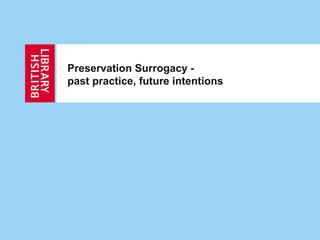
Preservation Surrogacy - Past practice, future intentions
- 1. Preservation Surrogacy - past practice, future intentions
- 2. Knowing the Need: next steps… Surrogacy should be re-examined as a preservation strategy Clarity must be achieved on the application of surrogacy as a preservation strategy Clarity must be achieved on the requirements for a digital object to act as a preservation surrogate Existing centralised resources listing the availability of surrogates should be investigated 2
- 3. What role does surrogacy play as a preservation strategy? Fundamentally a preservation tool – surrogacy protects & preserves original items that are vulnerable by creating a copy that is useable in its stead e.g. preservation microfilming can be defined as the creation of microfilm to high standards in order to produce a long-term surrogate to be used in the place of fragile original material. [National Preservation Office, Guide to preservation microfilming, 2000] 3
- 4. Why do we need preservation surrogates? 4
- 5. What are the alternatives? Increasing physical strength e.g. lining, lamination De-acidification (combined with cool storage) Boxing and safe handling Reduction in handling 5
- 6. Key attributes of a preservation surrogate A copy of an item which replicates as far as possible the characteristics of the original as required by most users The surrogate must be able to be discovered by users, and must be issued in lieu of the original item Crucially - the surrogate itself must be able to be preserved for an agreed period of time (do it once do it right) 6
- 7. Surrogates of the past – traditionally microfilm clear and accepted standards of production for preservation purposes - master negative, duplicate negative, positive quick availability of the positive cheap accepted longevity of the medium – master negative, in the appropriate storage, will last for several hundred years 7
- 8. Surrogates of the past – traditionally microfilm British Library started microfilming in the 1950s, with equipment donated to its newspaper repository at Colindale by the Rockefeller Foundation Projects such as the Mellon Microfilming Project introduced clear standards and encouraged/funded wide spread microfilming projects At the height of production, the British Library unit had over 20 cameras British Library, internally & externally, was producing over 2 million frames of preservation standard microfilm each year 8
- 9. Microfilm as a surrogate What counted as a faithful copy of the original? User experience Relationship to the original Preservation 9
- 10. An effective strategy? Only 6% of all surveyed items had a useable surrogate Of those with surrogates, there is no real correlation between the condition of the original and the production of a surrogate (items in good condition had a similar level of surrogacy as items classified as unusable) Why? 10
- 11. Surrogacy in a digital age Re-examining surrogacy as a preservation strategy Do we still need to create surrogates? For the same reasons? What does digital technology offer as an alternative to microfilm? 11
- 12. Surrogacy in a digital age What’s the difference? Digital copy created for access generally not expected to have as long a life span as a digital copy created for preservation purposes? Digital copy created for preservation – more rigorous standards required? Preservation of the digital surrogate - commitment to actively manage master files for a given period of time? 12
- 13. Surrogacy in a digital age What’s the problem? Are we comfortable using digital objects as preservation surrogates? If not, why not? Is it our definition of ‘a long time’? 13
- 14. Are we nearly there yet? Does digital access lead to more or less use of the original? digital Copyright 14
- 15. Surrogacy in a digital age Clarity must be achieved on the requirements for a digital object to act as a preservation surrogate lots of information out there do we need consensus? does everyone need to do the same thing? are there minimum requirements, or principles that it would be beneficial to agree? 15
- 16. Centralised resources 16
- 17. Thank you 17
